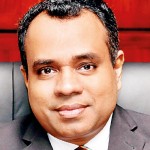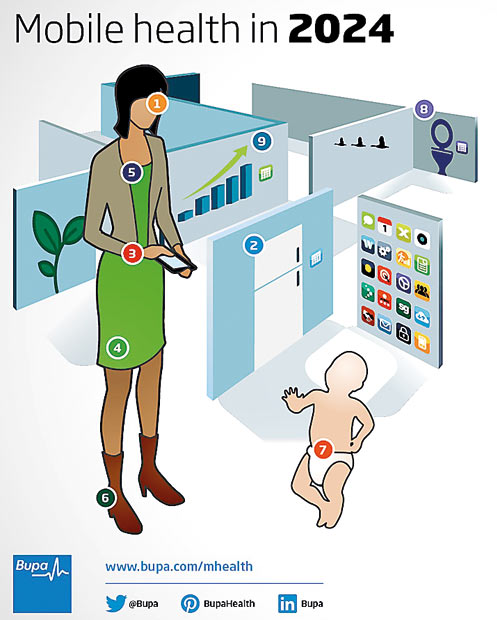Harnessing the potential of m- and e-Health, Big Data and Genomics
In today’s fast moving world, health is wealth, and keeping healthy is all about ‘monitoring’ your ‘vital signs’ and reminding you about those essential things in life that you forget. This, for example, is that you have not walked enough today, that you need to take your medicine on time (if you are on medication for a chronic disorder), etc. Today, we live in a world where health and IT are interlinked, that is why we talk of e-Health and m-Health. Self-monitoring devices are here to stay. It is not only the wearables that would soon look after your health; your refrigerator and your toilet at home, and even the clothes that you wear will be monitoring you as illustrated in the figure on the right.

Prof. Vajira H. W. Dissanayake
Diagnostic wearables
The convergence of health care and information and communication technology has already happened and where this technology would take us is up to one’s imagination. The global diagnostic wearable devices market was estimated at US$1472.5 million in 2012. It is growing, and growing rapidly. Sri Lanka is not known for producing medical devices, but it has a well-established software industry. Development of apps for these devices will be a major growth area in the future, and it is necessary for the leaders in IT to position Sri Lanka appropriately.
Biomedical informatics
In addition to its strength in IT, Sri Lanka already has a yet untapped and unknown strength. In 2008, the Postgraduate Institute of Medicine, University of Colombo, established a MSc course in Biomedical Informatics, a first of its kind in the world, where medical doctors and dental surgeons were trained in cutting edge e-Health technologies. So far this course has produced nearly 90 graduates who are embedded in the healthcare system of Sri Lanka. Their professional association is the Health Informatics Society of Sri Lanka (HISSL). Armed with this pool of IT-savvy Health Informatics specialists, HISSL is now moving away from being a traditional professional association to one which is taking aim at new challenges, with the vision of positioning Sri Lanka as a hub for e-Health regionally and globally. Today, while the direct-to-consumer healthcare market is booming due to wearable devices, health systems of all countries are struggling to implement Electronic Patient Records and Public Health Information Reporting Systems. The World Health Organisation (WHO) in collaboration with the International Telecommunications Unit (ITU), and large funding organisations like the Global Fund and Norad, have come forward to help countries develop system on two open source platforms, DHIS2 (dhis2.org) and OpenMRS (openmrs.org). Innovation on these platforms will be the order of the day in the future and Sri Lankan companies such as Brandix i3 have already positioned themselves to take advantage of this opportunity. HISSL, which has strategic partnerships with the global DHIS2 and OpenMRS movements, is also positioning itself to play a significant role in this space.
Big health data
The installation of these systems would lead us to the next major challenge – Big Data. Big Data is undoubtedly the next frontier for innovation, competition, and productivity. Big health data would get even bigger when genomic data is added on to it. The convergence of these data sets is the event that will convert health care from being primarily based on curative treatment, when one falls sick, to helping one to maintain health and wellbeing.
To harness that potential, software platforms facilitate crowdsourcing to gather and analyse data in a secure, ethical and controllable manner where innovations could be patented and benefits of commercialisation of such discoveries could be shared with patient and inventor communities that contributed to what will be built. That is a challenge that we are only waking up to now.
This is the big picture. We need to understand the nuts and bolts of it and position Sri Lanka to harnessing the full potential of m- and e-Health, Big Data and Genomics. It is not an option; it is a necessity if Sri Lanka is to survive in the bio-economy of the future.
About the writer:
Prof. Vajira H. W. Dissanayake – MBBS, PhD, FNASSL is the Director and Medical Geneticist at the Human Genetics Unit, Faculty of Medicine, University of Colombo. He is the Founder Chairperson (in 2008) of the Specialty Board in Biomedical Informatics, Postgraduate Institute of Medicine, University of Colombo; and Founder Secretary (in 1998) and the current President (since 2009) of the Health Informatics Society of Sri Lanka. He can be contacted via
vajirahwd@hotmail.com.
| The following provides a description for the items in the graphic: 1.Contact 2. Fridge 3. Artificial pancreas 4. Clothes 5. Thermometer patch 6. Shoes and socks 7. Nappies 8.Toilet 9. Monitoring |



